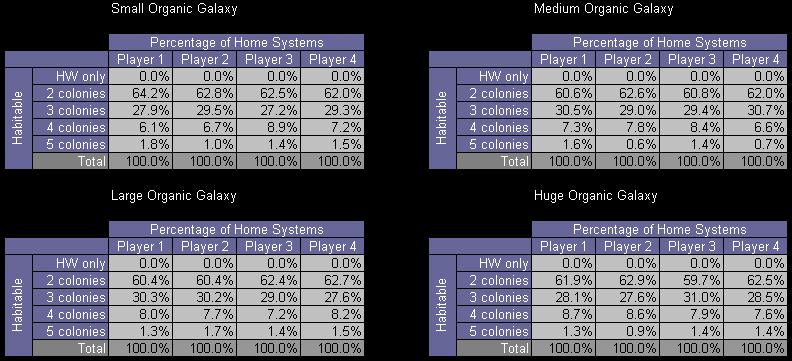After reading the great post by Trixx on Siron's blog, I have decided to post some data I have collected last summer. The reason I have collected this data is because I hope to someday balance the map so that it is reasonably fair for all players.
For the purpose of this analysis, I have used 1000 save games of each galaxy size. Each map was generated with 4 players. The galaxy age was set to organic rich and the technology age was set to Average. Master of Orion II version 1.40b19 patch was used to generate the maps without any switches and the game was exited on turn 1. The reason I have chosen these setting was because they are the most common settings I play on Kali.
The first set of data I collected was relating to the types of stars generated by the map generator. Trixx has some similar results however the total number of stars/black holes in all galaxies was constant. I did not see any variation.
As you can see from the above data there is some small variations in the averages between different galaxy sizes. I suspect if the number of save games used was more, there would be no variations at all.
Next, I took a quick look at home systems. In particular, I was interested in the number of usable planets in the home systems. How many can be colonized? I did not take into account whether or not these planets were worth colonizing. They were only counted. Asteroid belts and Gas Giants were not counted.
Again, you can see some small variations that likely would not be seen had I used more save games.
As a side note, from this data you can derive some numbers showing the effects of the /planets switch. It is coded to simply increase the number of planets to be generated when fewer planets were going to be generated. In other words for /planets=4 you can simply add the values for '2 colonies' , '3 colonies' , and '4 colonies' together to calculate the odds of getting 4 planets. In this case you will still have the same chance of getting 5 planets as without the switch.
My next focus was to gather some data pertaining to what I consider the biggest problem with the map generator. There are often not enough decent systems within 6 parsecs of a home system. In general, most players will not land their first colony ship in a system that has fewer than two colonizable planets. Some players will settle a system that has only one planet, others will just make an outpost and keep searching. Either way, these maps usually give one player a huge advantage over another and are a little unfair.
From this, you can pretty much conclude that about 45% (estimate) of the systems you scout early will not have 2 or more planets and thus are useless. I think this number is a little high and I would like to see some improvement in these nearby star systems.
The data I collected next was not very encouraging but, I had a feeling these numbers would be high from experience. Basically this data shows the percentage of games where there are no suitable systems to colonize within 6 parsecs of a players home system. By suitable I mean, it has one or fewer colonizable planets.
From this you can estimate that in a medium or large galaxy about 25% (sum of the stats) of the time somebody in the game will have a rough start.
After looking at these numbers, I think I will look into improving the map balance in a upcoming patch release...
January 16, 2006
Quick Map balance Analysis
Posted by
Lord Brazen
at
Monday, January 16, 2006
![]()
| News | ||
| Game Setup | ||
| Patch FAQ | ||
| Downloads | ||
| Community Forum |
|
Interested in playing a game? Meet other players in an IRC chat session: |
| Sirons Blog | ||
| Moo2 Star League | ||
| Moo3 Guardian | ||
| The Orion Sector | ||
| The Last Orion |
|
Unique Visitors
Since Feb 2005 |
1 comment:
Very nice work.
With a few exceptions (gaia, terran or a nice urich for tol) singletons are useless and settling them means losing. The game designers were probably unaware of this problem since they underestimated the strength of 1pop housing.
Any idea if there is a balance algorithm in the exe? Or is it just random and very volatile?
Post a Comment